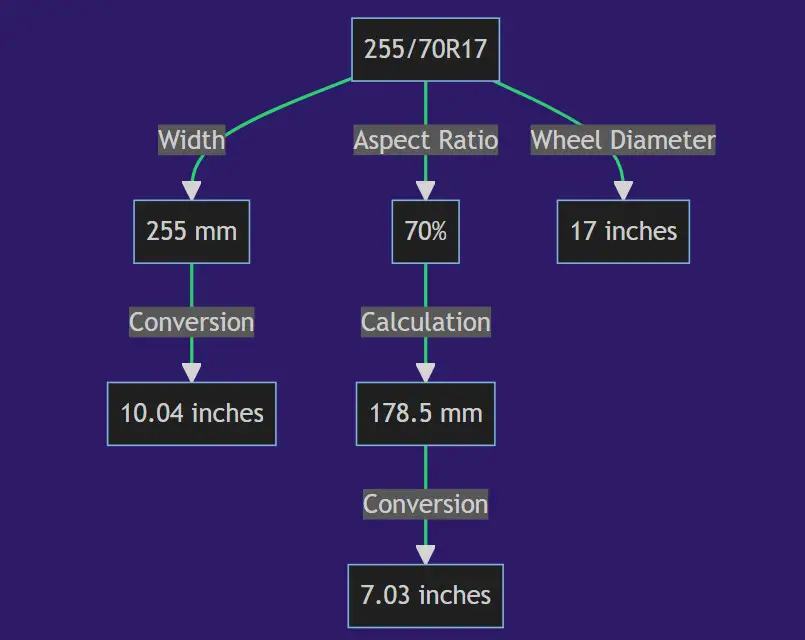The 255/70R17 tire has an overall diameter of approximately 31.1 inches, a section width of roughly 10 inches, and is designed to be mounted on a 17-inch diameter rim. The equivalent tire size in the high flotation system is 31.1x10R17.

What does 255/70r17 Tire mean?
Ah, the mystery of tire markings. At first glance, it might seem as cryptic as grandma’s secret meatloaf recipe, but we’re going to demystify it together. Let’s decode this “255/70r17” in a neat table. Buckle up!
| Tire Number | Explanation |
| 255 | This is the section width of the tire, measured in millimeters (mm). It represents the widest part of the tire when properly mounted and inflated. |
| 70 | This is the aspect ratio. It’s a percentage that shows the height of the tire sidewall as a percentage of the section width. In this case, the sidewall height is 70% of the 255mm width. |
| R | This stands for Radial. It means the tire’s construction type. In a radial tire, the internal ply cords are positioned in a radial direction, around the center of the tire. |
| 17 | This is the wheel diameter. It’s the size, in inches, of the wheel that the tire is designed to fit. A 255/70R17 tire is made for a 17-inch wheel. |
What is 255/70r17 Tire in inches?
You might wonder why we’re using both inches and millimeters here. Well, it’s because tire measurements are a mixed bag of metric and imperial systems, just like a good bowl of trail mix. We can convert the section width and sidewall height into inches for our American friends.
Tire Size Conversion: 255/70r17 in Inches and Millimeters
This tire size can be a bit difficult to visualize. To help, here’s a table that breaks down the measurements of a 255/70R17 tire in both inches and millimeters.
| Measurement | Inches | Millimeters |
| Tire Diameter | 31.1 | 790 |
| Section Width | 10 | 255 |
| Rim Diameter | 17 | 432 |
| Sidewall Height | 7.0 | 178.5 |
| Circumference | 97.6 | 2480 |
| Revolutions per Mile | 649 | – |
The tire diameter is calculated using the section width, aspect ratio, and wheel diameter. Sidewall height is derived from the aspect ratio percentage of the section width. The tire circumference is calculated using the diameter, and revolutions per mile are calculated from the circumference. The math can be a little intimidating, but don’t worry – you won’t be quizzed on it later!
Just as a fun fact, remember that each tire revolution on a 255/70R17 covers about 97.6 inches – that’s roughly the height of an adult male giraffe’s heart! And you thought tire size wasn’t interesting.
Now you can confidently decipher tire dimensions as easily as your morning crossword. It’s an underappreciated art form, but we’re glad to be on this enlightening journey with you. So next time, when someone is lost in the labyrinth of tire sizes, you can guide them out, all thanks to your newfound understanding of a tire’s ‘mysterious’ numbers and letters!
Tire Width of 255/70r17
The tire width, or section width as it’s sometimes called, is that “255” nestled at the start of our “255/70r17” tire size. It indicates the width of the tire in millimeters from sidewall to sidewall. Picture two slices of bread as the sidewalls and the delicious filling in the middle as the tread.
In this case, that filling is a mouthwatering 255 millimeters (or about 10 inches for those who prefer their sandwiches in imperial measurements). As they say, more width, more stability – or is that just something we say in the tire world?
Tire Height of 255/70r17
Now, tire height, or diameter, is a bit of a tricky one. It’s not directly provided in the size “255/70r17”, so we have to do some math to figure it out. Here’s how: We first determine the sidewall height (70% of 255mm, which is approximately 178.5mm), multiply this by 2 (because tires have two sidewalls, you know), and then add the diameter of the rim (17 inches, which is 432mm).
All this sums up to approximately 790mm, or about 31.1 inches. This tire isn’t quite Shaquille O’Neal tall, but it’s a pretty good size for getting you over those potholes.
Sidewall Height of 255/70r17
Next up, we have the sidewall height, represented by that “70” in our tire size. This isn’t a direct measurement in millimeters or inches, but a percentage of the tire width. A 70 aspect ratio means the sidewall height is 70% of the tire width.
So, take 70% of 255mm, and we get approximately 178.5mm, or about 7 inches. That’s about 18 stacked Oreos – not that we recommend using cookies as a measurement tool, but it does sound like a tasty experiment!
Rim Diameter for 255/70r17
The “17” in “255/70r17” tells us the rim diameter in inches. So, we’re dealing with a 17-inch rim here. The tire is designed to snugly fit on a rim of this size, like a well-tailored suit or a perfectly toasted bagel fitting beautifully on your morning plate. For our metric system friends, that’s 432mm.
Tire Circumference of 255/70r17
Lastly, the tire circumference isn’t explicitly written in the tire size, but we can calculate it using the tire diameter. Multiply the diameter (31.1 inches) by π (3.14), and we get a circumference of about 97.6 inches, or 2480mm.
This is the distance your vehicle will travel with one complete spin of the wheel. If you drove around the earth’s equator, your tire would have to turn over 1,034,363 times! Now that’s a road trip!
What are the best 255/70r17 tires?
Choosing the best tire is like picking the best dessert – it depends on the occasion, your preferences, and yes, sometimes even the weather. If you’ve been wondering what the best 255/70r17 tires are, you’re in the right place! We’ve done some tire-kicking research and have found three top contenders for you. Let’s check them out!
1 – Yokohama GEOLANDAR H/T G056 – 255/70R17 110T
The GEOLANDAR H/T G056 from Yokohama is like the Swiss Army knife of tires: versatile, reliable, and always ready for action. It’s designed for all seasons, so whether you’re driving under the summer sun or navigating snowy streets, this tire’s got your back. It offers exceptional tread life and a quiet, comfortable ride.
Key Features
- All-season tread design
- Triple 3D sipes improve braking and stability
- Adaptive Shoulder Blocks form a continuous rib to reduce tread noise
Pros
- Versatile for various weather conditions
- Enhanced stability and braking
- Reduced road noise for a quieter ride
Cons
- Not as aggressive for off-roading
Final Recommendation The Yokohama GEOLANDAR H/T G056 is perfect for drivers seeking a quiet, comfortable ride with good all-round performance. However, hardcore off-roaders may want something a bit more rugged.
2 – Hankook DynaPro HT RH12 Radial Tire – 255/70R17 110T
The Hankook DynaPro HT RH12 is like the little black dress of tires: classic, stylish, and always a good choice. It delivers well-rounded performance for both on and off-road driving. With excellent traction, stability, and resistance to wear, it’s a tire you can trust.
Key Features
- High-strength steel belts improve steering response
- Rubber compound enhances tread life
- Computer-optimized tread design reduces road noise
Pros
- Good on-road and moderate off-road performance
- Durable and long-lasting
- Quiet and comfortable ride
Cons
- Might struggle in heavy snow conditions
Final Recommendation The Hankook DynaPro HT RH12 is an excellent all-rounder that shines in most driving conditions. However, for those living in heavy snow areas, a more winter-oriented tire might be a better fit.
3 – BFGoodrich All Terrain T/A KO2
The BFGoodrich All Terrain T/A KO2 is the Superman of tires: tough, resilient, and not afraid of a little adventure. This tire is designed to conquer any terrain – from rocky trails to smooth highways. It features an aggressive tread design for excellent off-road traction, while still providing a comfortable ride on paved roads.
Key Features
- CoreGard Technology for improved sidewall strength
- Serrated shoulder design offers great maneuverability on soft soil and deep snow
- Interlocking tread design extends tread life
Pros
- Exceptional off-road performance
- Resilient and puncture-resistant
- Good longevity
Cons
- Might be a bit noisy on highways
Final Recommendation The BFGoodrich All Terrain T/A KO2 is ideal for off-road enthusiasts who need a tire that can keep up with their adventures. However, if most of your driving is on smooth pavement, you might prefer a quieter tire.
FAQ’s About 255/70r17 Tire
We’ve dived deep into the specifics of the 255/70r17 tire. Now it’s time for a rapid-fire Q&A session where we answer some common queries. You’re one step away from becoming the tire guru in your neighborhood, so let’s jump right in!
What vehicles use 255/70r17 Tire?
The 255/70r17 tire size is fairly popular and you’ll find it on a variety of vehicles, usually light trucks and SUVs. These can include the Jeep Wrangler, Ford Ranger, Ford F-150, Chevrolet Colorado, and Toyota Hilux, among others. Always make sure to check your vehicle’s owner manual or consult a tire professional to confirm the correct tire size for your ride.
How many revolutions per mile does a 255/70r17 have?
For a tire of this size, we’re looking at approximately 649 revolutions per mile. This is calculated based on the overall tire diameter. So, with every mile you cover, your tires are completing this dizzying number of revolutions. Talk about going for a spin!
Price of 255/70r17 inches Tire?
Tire prices can vary quite a bit depending on the brand, model, and where you’re shopping. As a ballpark, you could expect to pay anywhere between $130 to $250 per tire for a 255/70r17 size. Premium models might even push north of this range. Remember, investing in good quality tires is like investing in a good pair of shoes – your safety and comfort are worth it!
What kind of rim does a 255/70r17 tire fit on?
As the last number in “255/70r17” suggests, this tire size fits on 17-inch rims. This is the diameter of the rim. The width of the rim suitable for this tire size is usually between 6.5 and 8.5 inches. Remember, the rim size should always match the tire for a secure and proper fit.
How much air should be in a 255/70r17?
The ideal tire pressure can depend on your vehicle’s specifications. Typically, a 255/70r17 tire would require a pressure of about 30 to 35 PSI (Pounds per Square Inch). Always consult your vehicle’s owner’s manual or a tire professional for the correct tire pressure. Maintaining proper tire pressure is crucial for optimum handling, safety, and tire lifespan.
What is a 255/70r17 equivalent to?
A 255/70r17 tire can be equivalent to various other tire sizes, including 31×10.00R17 or 265/65R17, depending on the aspect ratios. These are called “Plus sizing” or “Minus sizing”. However, before you consider switching sizes, always consult a tire or automotive professional to ensure the alternate size is suitable for your vehicle and driving conditions.
Comparison with similar tires
Tire sizes can feel like a cryptic code. Fear not, we’re here to crack the cipher and compare the 255/70r17 tire to similar sizes. It’s time to be the Sherlock Holmes of the tire world!
255/70r17 vs 265/70r17:
The main difference is the section width (265mm vs 255mm). This means the 265/70r17 is slightly wider, potentially providing a small increase in stability and load-carrying capacity.
255/70r17 vs 265/65r17:
Here, the first tire is narrower but has a taller sidewall compared to the 265/65r17. This could influence ride comfort, handling, and appearance.
255/70r17 vs 285/70r17:
The 285/70r17 is wider and has a taller sidewall, which may offer better off-road performance but could impact fuel efficiency.
255/70r17 vs 255/75r17:
Both tires have the same width, but the 255/75r17 has a taller sidewall. This could mean a higher vehicle stance and potentially better off-road capability.
255/70r17 vs 245/75r17:
The 245/75r17 is narrower but has a taller sidewall compared to the 255/70r17. This might impact handling and ride comfort.
255/70r17 vs 245/70r17:
Both tires have the same sidewall height, but the 245/70r17 is narrower. This could influence the tire’s grip and handling characteristics.
255/70r17 vs 265/75r16:
The 265/75r16 is wider and has a taller sidewall but fits a smaller 16-inch rim. This could mean improved off-road performance at the cost of a potentially less comfortable ride.
255/70r17 vs 275/70r17:
The 275/70r17 is wider and has a slightly taller sidewall, which might provide better traction but could negatively affect fuel economy.
255/70r17 vs 275/55r20:
The 275/55r20 is wider, has a significantly shorter sidewall, and fits a larger 20-inch rim. It could offer sportier handling but might not perform as well in off-road conditions.
255/70r17 vs 275/60r20:
The 275/60r20 is wider, has a taller sidewall, and fits a larger 20-inch rim. It could provide better traction and load capacity but might be less fuel-efficient.
Conclusion
The universe of tire sizes is vast and can be a bit confusing. But remember, your tire size is more than just numbers and letters; it can significantly influence your vehicle’s performance, handling, and comfort.
While it’s intriguing to consider the differences between various tire sizes, always consult a tire professional before deciding to switch sizes. Now, equipped with all this tire knowledge, you’re ready to hit the road, conquer terrains, and embark on countless adventures!

AR Jeet has been a tire mechanic for over 2years. He has worked on all types of vehicles, from cars and trucks to RVs and ATVs and motorcycles. He has seen it all when it comes to tires, and he knows how to fix them.
AR Jeet is a tire expert, and he is passionate about his work. He loves to help people keep their vehicles running smoothly, and he is always happy to answer any questions that people have about their tires.
If you need help with your tires, or if you just want to learn more about them, then AR Jeet is the man to talk to. He will be happy to help you out, and he will make sure that you get the best possible solution.
He has a blog [Tirespick.com] where he writes about all things tire-related, and he is always happy to help people with their tire needs. Know more about AR Jeet.
